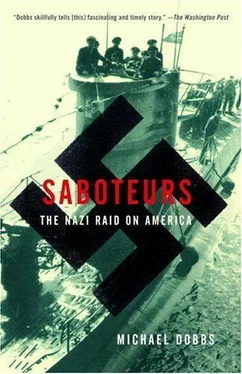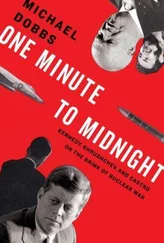In the absence of any other appeal mechanism, the president was meant to act as a final reviewing authority for the case. But as he perused the Sunday papers in his bedroom, Roosevelt had pretty much made up his mind. He felt the case had already consumed far too much time and energy. “It’s always hard for generals to act as judges,” he mused. “I hope they don’t string it out too long. They ought to bring in a verdict just like a jury.” Knowing the way generals worked, however, he braced himself for a “wordy report.” 1
“A veritable bale of papers” duly arrived at Hyde Park late on Monday afternoon, transported from Washington by military plane. The package included the 2,967-page transcript of the trial and a series of guilty verdicts. The military judges had sentenced all eight defendants to death by electrocution. However, they also suggested clemency for Dasch and Burger in recognition of the assistance they had provided to the FBI. In Dasch’s case, the commission recommended imprisonment for thirty years with hard labor; in Burger’s, imprisonment for life.
Although no records have survived of the commission’s deliberations, it seems unlikely there was much debate over the verdicts. In their questioning of the prisoners, the judges were uniformly hostile to the defense. Neither McCoy nor his subordinates showed any patience with the legal points raised by defense attorneys. From their point of view, technical legal arguments were irrelevant, as they were under instructions from the president to apply a “reasonable man” standard to the evidence. Royall got the impression from the beginning that “the Commission was against us,” which was why he put so much stock in his appeal to the Supreme Court. 2
Roosevelt had heard from Biddle two weeks earlier that Dasch and Burger “were helpful in apprehending the others and in making out the proof.” 3He was unaware of the full extent of their cooperation, although Biddle had suggested that it might be useful to make Dasch “somewhat of a hero, thus encouraging other German agents to turn in their fellows, and making all agents suspect each other.” The attorney general noted that Burger did not want any publicity at all, and “prefers death to endangering his family.” By the end of the trial, Biddle was so exasperated with Dasch that he dropped the idea of turning him into a hero.
The president mulled over what to do with the saboteurs on the overnight train back to Washington. When he reached the White House on Tuesday morning, he summoned his legal advisers for a review of the case, which lasted much of the afternoon. By this time, he had already decided to accept all the military commission’s recommendations, including use of the electric chair as the means of execution, despite his earlier preference for hanging. He had no intention of submitting the trial record to the judge advocate general’s office, as the defense lawyers were urging. But appearances had to be maintained. When the meeting with his lawyers wound up at 4:10 p.m., Roosevelt called reporters into the Oval Office and told them he was busy reviewing the “voluminous” evidence in the case. It would likely take “two or three days” to “finish my labors.” 4
“Are you more or less, sir, putting everything else aside during that period?” a reporter wanted to know.
“Oh my, no,” replied Roosevelt cheerfully, looking the picture of relaxation in a tieless white shirt and seersucker trousers.
By this time, the Justice Department had already alerted General Cox, the provost marshal, that the president would order “execution by electrocution” for six of his prisoners. 5Cox would be in charge of the most dramatic mass execution in American history since the hanging of the Lincoln conspirators. He had to find executioners, chaplains, and medical officers; arrange for a supply of additional electric current; and make sure that “Old Sparky,” as the D.C. jail’s venerable electric chair was known, was in good working order. He also had to plan for disposal of the bodies.
What was more, everything had to be done in total secrecy.
AS THEY waited in solitary confinement in the women’s section of the D.C. jail, the prisoners were fast losing hope. They displayed little outward emotion and spent long periods of time alone in their cells, smoking and staring at the walls. Occasionally, against prison regulations, the guards asked them to sign souvenirs. “To a fine American soldier,” Richard Quirin scrawled on a paper cup presented to him by a military policeman.
Early on in the trial, some of the saboteurs complained they could not get to sleep because of the harsh lighting in their cells. 6Cox ordered the lighting to be dimmed, but never entirely turned off, as he was determined to keep the prisoners under twenty-four-hour observation to prevent suicide attempts.
The saboteurs tried to put their affairs in order as best they could while waiting for the verdict. The most energetic was Eddie Kerling. Always a prolific correspondent, he wrote lengthy farewell letters to his wife, his mistress, his best friend, and to Miriam Preston, the American girl living in Massachusetts with whom he had been friendly. “Our fate is up to the President,” he told his wife Marie, who was herself in FBI custody in New York City. 7“This means the end of my life. We have to part. I know you can’t grasp that. Neither can I.” He had always been ready to die a soldier’s death for the Fatherland. His only regret was that he was sent on “a hopeless mission where we could not be of any service to our country.”
As he prepared for his death, Kerling tried to make sense of the confused love triangle between himself, Marie, and Hedy Engemann. He blamed himself for “not being a better husband while I had the chance” and asked Marie’s “forgiveness for all the headaches and sorrow I have caused you.” He admitted his feelings for Hedy, but insisted that his wife remained dearer to him than anyone in the world. “When I have to go on my last walk, I’ll think of you, my Marie. I know you’d give your life to see me happy. I was a fool not to have seen it. When I realized what I had left behind, it was too late.” His final advice to Marie was to stick close to Hedy.
His next letter was to Hedy, “my very dear friend.” He told her that he had just finished a long letter to Marie in which “I tore my heart out to let her know how much I love her.” His main reason for taking part in Operation Pastorius was to “help” his wife and “win her back.” He knew from the beginning that the sabotage mission would fail. “I cannot explain why! Yet I hoped to be able to hide until the war blew over.” He thanked Hedy for testifying on his behalf before the military tribunal. “Hedy, you have helped me, but our case was too hopeless. So it is all over now… Remember me as you have known me in happier days, forget the tragic end.”
He apologized to Helmut Leiner, the tuberculosis patient from Astoria, for getting him in trouble with the FBI “after those two years you have spent in a hospital bed fighting for your life.” Leiner was one of several dozen German-Americans accused of cooperating with the saboteurs. “I tried to keep you out of it, but they already knew about you.” After thanking Leiner for arranging meetings for him in New York with Marie and Hedy, he gave him one final piece of advice. “Helmut, get that girl [Hedy] for yourself. You both will be happy.”
Writing to his friend Miriam, he asked that she not judge him too harshly. “I did bring some dynamite, but not any hate for America or Americans.” He complained of the power of propaganda—in both Germany and the United States—and pleaded for her respect and understanding. “I have done my duty to my country as any American would for his [and now] we have to take the punishment for it. It is foolish to say that it is easy to take. But I hope that we manage to make a decent show of it.”
Читать дальше












